Assignment on Teaching Plan
VerifiedAdded on 2022/08/26
|11
|2369
|27
AI Summary
Contribute Materials
Your contribution can guide someone’s learning journey. Share your
documents today.
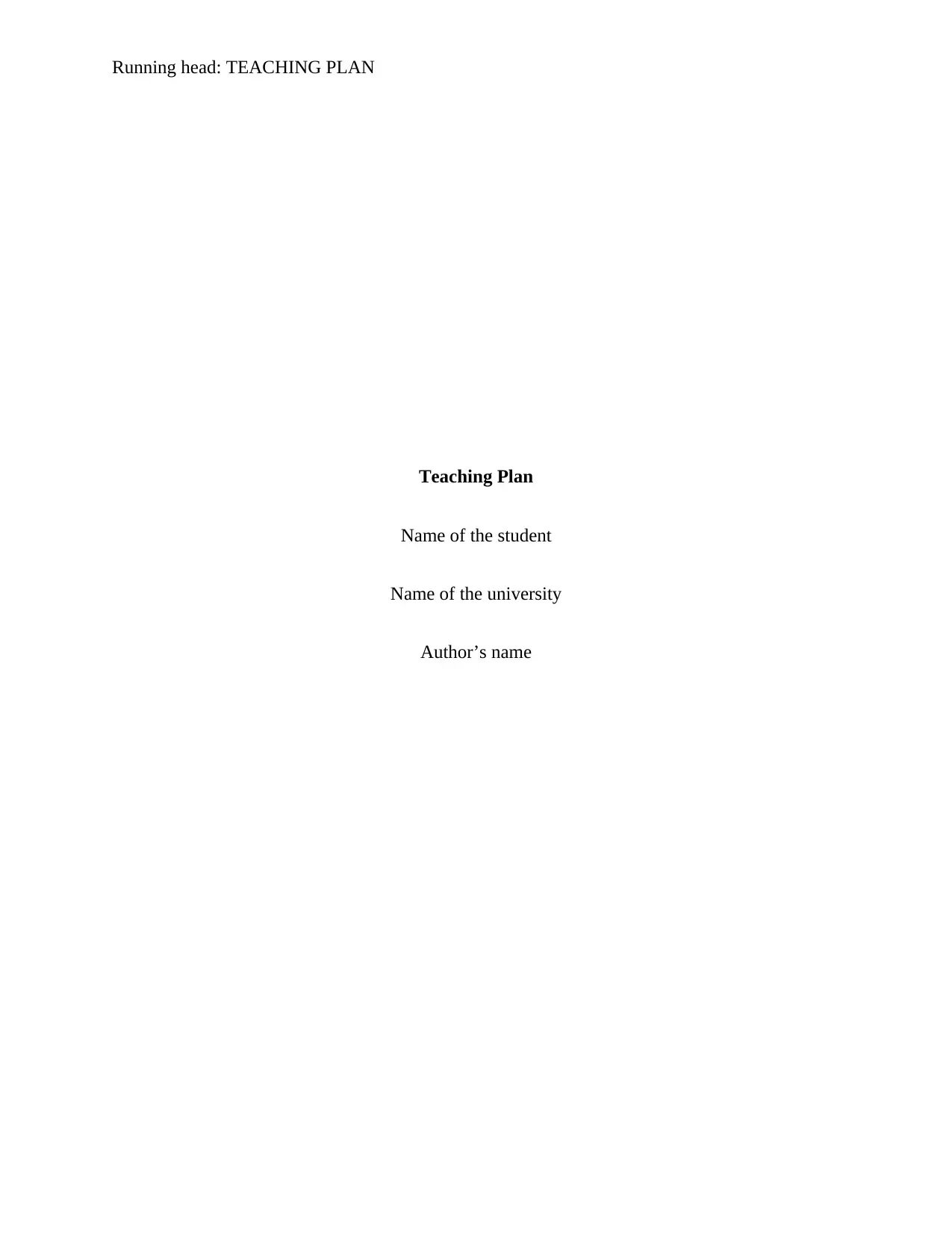
Running head: TEACHING PLAN
Teaching Plan
Name of the student
Name of the university
Author’s name
Teaching Plan
Name of the student
Name of the university
Author’s name
Secure Best Marks with AI Grader
Need help grading? Try our AI Grader for instant feedback on your assignments.
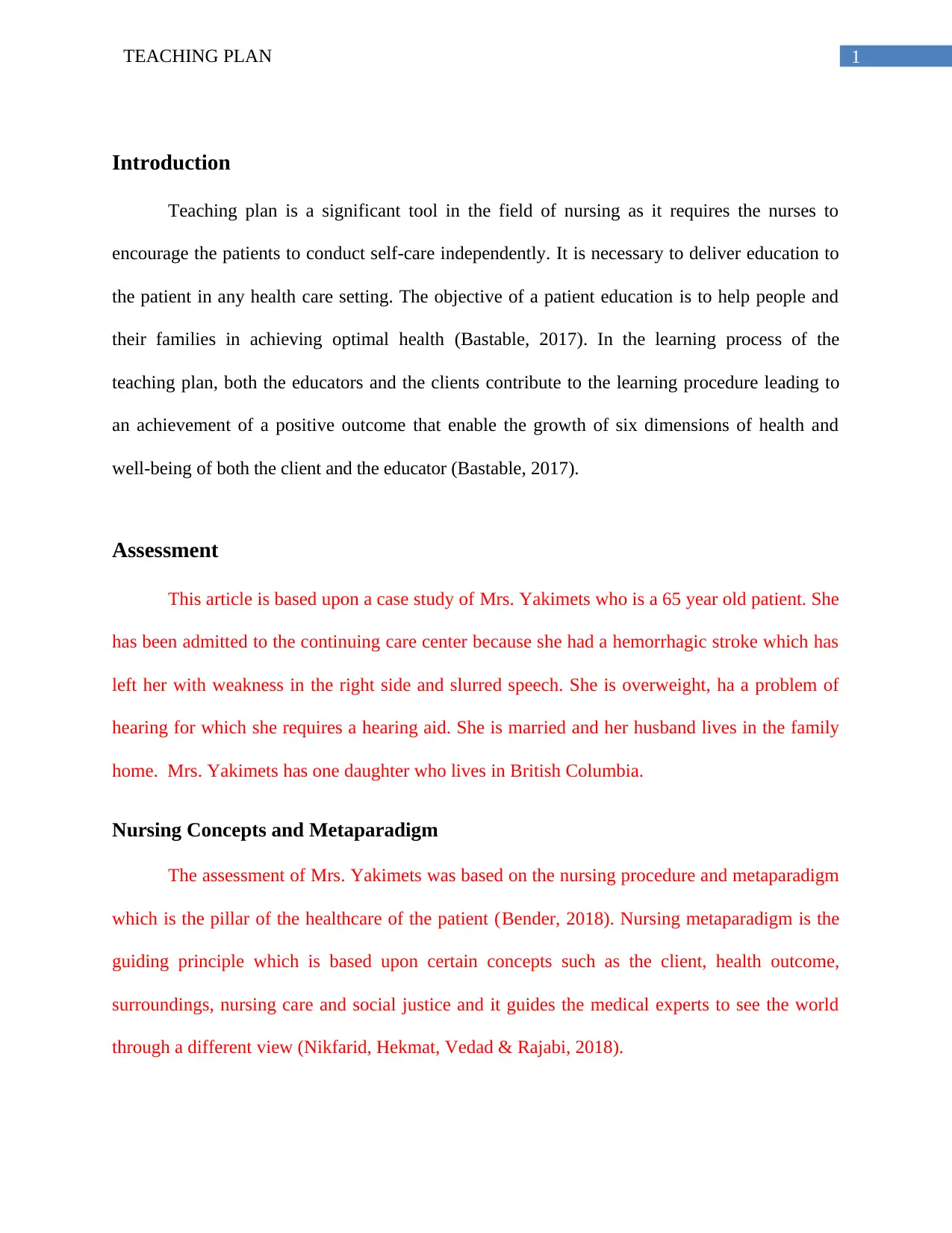
1TEACHING PLAN
Introduction
Teaching plan is a significant tool in the field of nursing as it requires the nurses to
encourage the patients to conduct self-care independently. It is necessary to deliver education to
the patient in any health care setting. The objective of a patient education is to help people and
their families in achieving optimal health (Bastable, 2017). In the learning process of the
teaching plan, both the educators and the clients contribute to the learning procedure leading to
an achievement of a positive outcome that enable the growth of six dimensions of health and
well-being of both the client and the educator (Bastable, 2017).
Assessment
This article is based upon a case study of Mrs. Yakimets who is a 65 year old patient. She
has been admitted to the continuing care center because she had a hemorrhagic stroke which has
left her with weakness in the right side and slurred speech. She is overweight, ha a problem of
hearing for which she requires a hearing aid. She is married and her husband lives in the family
home. Mrs. Yakimets has one daughter who lives in British Columbia.
Nursing Concepts and Metaparadigm
The assessment of Mrs. Yakimets was based on the nursing procedure and metaparadigm
which is the pillar of the healthcare of the patient (Bender, 2018). Nursing metaparadigm is the
guiding principle which is based upon certain concepts such as the client, health outcome,
surroundings, nursing care and social justice and it guides the medical experts to see the world
through a different view (Nikfarid, Hekmat, Vedad & Rajabi, 2018).
Introduction
Teaching plan is a significant tool in the field of nursing as it requires the nurses to
encourage the patients to conduct self-care independently. It is necessary to deliver education to
the patient in any health care setting. The objective of a patient education is to help people and
their families in achieving optimal health (Bastable, 2017). In the learning process of the
teaching plan, both the educators and the clients contribute to the learning procedure leading to
an achievement of a positive outcome that enable the growth of six dimensions of health and
well-being of both the client and the educator (Bastable, 2017).
Assessment
This article is based upon a case study of Mrs. Yakimets who is a 65 year old patient. She
has been admitted to the continuing care center because she had a hemorrhagic stroke which has
left her with weakness in the right side and slurred speech. She is overweight, ha a problem of
hearing for which she requires a hearing aid. She is married and her husband lives in the family
home. Mrs. Yakimets has one daughter who lives in British Columbia.
Nursing Concepts and Metaparadigm
The assessment of Mrs. Yakimets was based on the nursing procedure and metaparadigm
which is the pillar of the healthcare of the patient (Bender, 2018). Nursing metaparadigm is the
guiding principle which is based upon certain concepts such as the client, health outcome,
surroundings, nursing care and social justice and it guides the medical experts to see the world
through a different view (Nikfarid, Hekmat, Vedad & Rajabi, 2018).
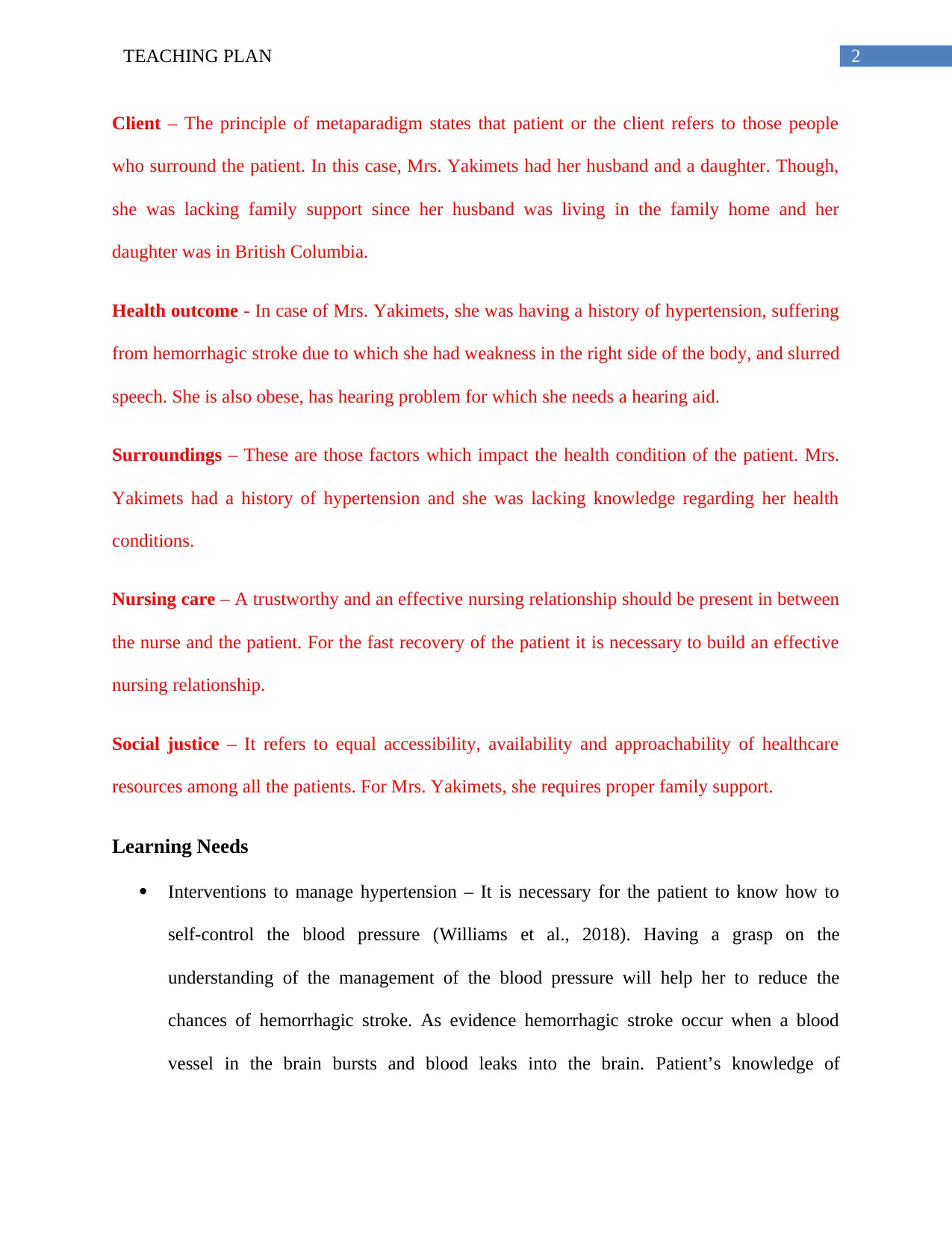
2TEACHING PLAN
Client – The principle of metaparadigm states that patient or the client refers to those people
who surround the patient. In this case, Mrs. Yakimets had her husband and a daughter. Though,
she was lacking family support since her husband was living in the family home and her
daughter was in British Columbia.
Health outcome - In case of Mrs. Yakimets, she was having a history of hypertension, suffering
from hemorrhagic stroke due to which she had weakness in the right side of the body, and slurred
speech. She is also obese, has hearing problem for which she needs a hearing aid.
Surroundings – These are those factors which impact the health condition of the patient. Mrs.
Yakimets had a history of hypertension and she was lacking knowledge regarding her health
conditions.
Nursing care – A trustworthy and an effective nursing relationship should be present in between
the nurse and the patient. For the fast recovery of the patient it is necessary to build an effective
nursing relationship.
Social justice – It refers to equal accessibility, availability and approachability of healthcare
resources among all the patients. For Mrs. Yakimets, she requires proper family support.
Learning Needs
Interventions to manage hypertension – It is necessary for the patient to know how to
self-control the blood pressure (Williams et al., 2018). Having a grasp on the
understanding of the management of the blood pressure will help her to reduce the
chances of hemorrhagic stroke. As evidence hemorrhagic stroke occur when a blood
vessel in the brain bursts and blood leaks into the brain. Patient’s knowledge of
Client – The principle of metaparadigm states that patient or the client refers to those people
who surround the patient. In this case, Mrs. Yakimets had her husband and a daughter. Though,
she was lacking family support since her husband was living in the family home and her
daughter was in British Columbia.
Health outcome - In case of Mrs. Yakimets, she was having a history of hypertension, suffering
from hemorrhagic stroke due to which she had weakness in the right side of the body, and slurred
speech. She is also obese, has hearing problem for which she needs a hearing aid.
Surroundings – These are those factors which impact the health condition of the patient. Mrs.
Yakimets had a history of hypertension and she was lacking knowledge regarding her health
conditions.
Nursing care – A trustworthy and an effective nursing relationship should be present in between
the nurse and the patient. For the fast recovery of the patient it is necessary to build an effective
nursing relationship.
Social justice – It refers to equal accessibility, availability and approachability of healthcare
resources among all the patients. For Mrs. Yakimets, she requires proper family support.
Learning Needs
Interventions to manage hypertension – It is necessary for the patient to know how to
self-control the blood pressure (Williams et al., 2018). Having a grasp on the
understanding of the management of the blood pressure will help her to reduce the
chances of hemorrhagic stroke. As evidence hemorrhagic stroke occur when a blood
vessel in the brain bursts and blood leaks into the brain. Patient’s knowledge of
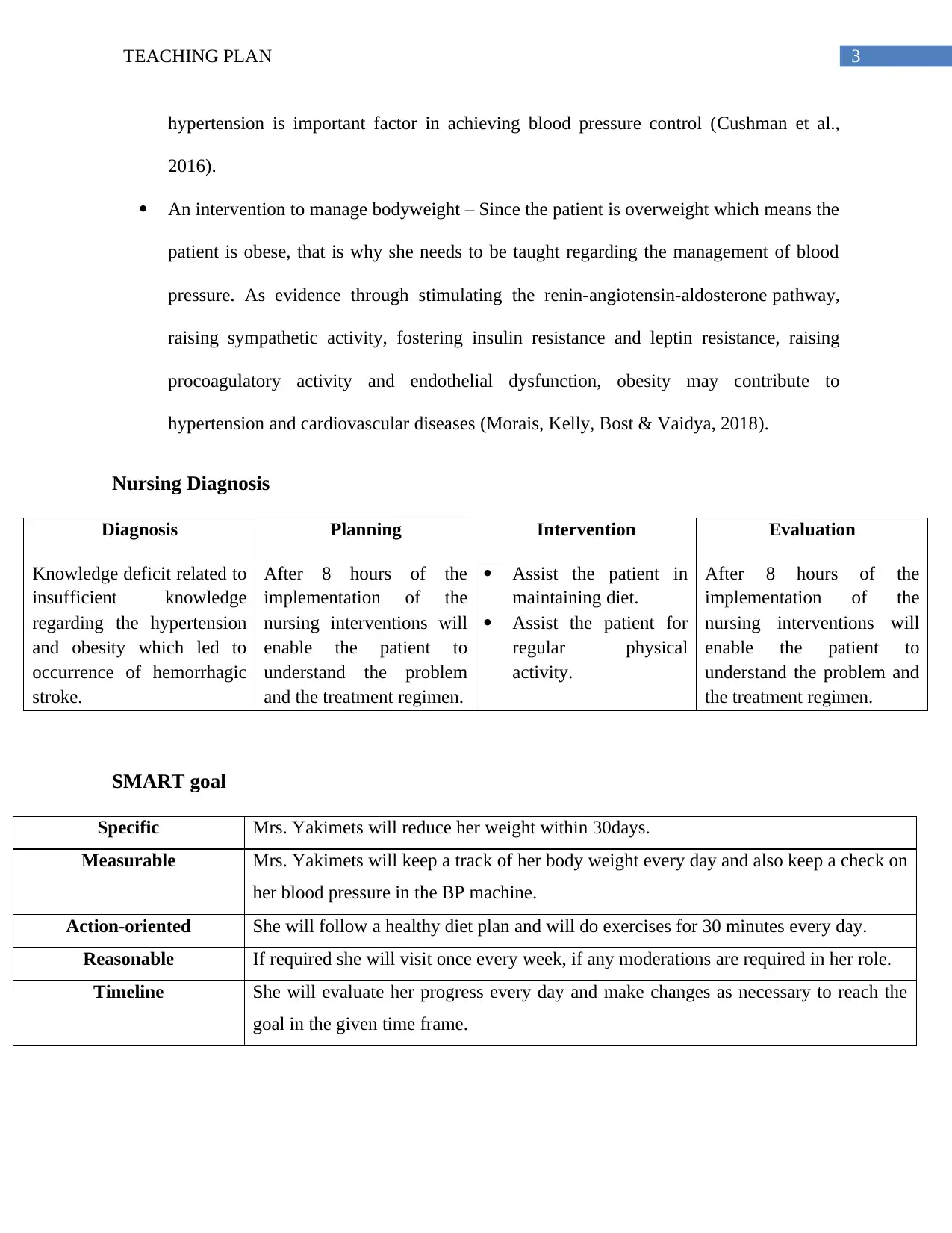
3TEACHING PLAN
hypertension is important factor in achieving blood pressure control (Cushman et al.,
2016).
An intervention to manage bodyweight – Since the patient is overweight which means the
patient is obese, that is why she needs to be taught regarding the management of blood
pressure. As evidence through stimulating the renin-angiotensin-aldosterone pathway,
raising sympathetic activity, fostering insulin resistance and leptin resistance, raising
procoagulatory activity and endothelial dysfunction, obesity may contribute to
hypertension and cardiovascular diseases (Morais, Kelly, Bost & Vaidya, 2018).
Nursing Diagnosis
Diagnosis Planning Intervention Evaluation
Knowledge deficit related to
insufficient knowledge
regarding the hypertension
and obesity which led to
occurrence of hemorrhagic
stroke.
After 8 hours of the
implementation of the
nursing interventions will
enable the patient to
understand the problem
and the treatment regimen.
Assist the patient in
maintaining diet.
Assist the patient for
regular physical
activity.
After 8 hours of the
implementation of the
nursing interventions will
enable the patient to
understand the problem and
the treatment regimen.
SMART goal
Specific Mrs. Yakimets will reduce her weight within 30days.
Measurable Mrs. Yakimets will keep a track of her body weight every day and also keep a check on
her blood pressure in the BP machine.
Action-oriented She will follow a healthy diet plan and will do exercises for 30 minutes every day.
Reasonable If required she will visit once every week, if any moderations are required in her role.
Timeline She will evaluate her progress every day and make changes as necessary to reach the
goal in the given time frame.
hypertension is important factor in achieving blood pressure control (Cushman et al.,
2016).
An intervention to manage bodyweight – Since the patient is overweight which means the
patient is obese, that is why she needs to be taught regarding the management of blood
pressure. As evidence through stimulating the renin-angiotensin-aldosterone pathway,
raising sympathetic activity, fostering insulin resistance and leptin resistance, raising
procoagulatory activity and endothelial dysfunction, obesity may contribute to
hypertension and cardiovascular diseases (Morais, Kelly, Bost & Vaidya, 2018).
Nursing Diagnosis
Diagnosis Planning Intervention Evaluation
Knowledge deficit related to
insufficient knowledge
regarding the hypertension
and obesity which led to
occurrence of hemorrhagic
stroke.
After 8 hours of the
implementation of the
nursing interventions will
enable the patient to
understand the problem
and the treatment regimen.
Assist the patient in
maintaining diet.
Assist the patient for
regular physical
activity.
After 8 hours of the
implementation of the
nursing interventions will
enable the patient to
understand the problem and
the treatment regimen.
SMART goal
Specific Mrs. Yakimets will reduce her weight within 30days.
Measurable Mrs. Yakimets will keep a track of her body weight every day and also keep a check on
her blood pressure in the BP machine.
Action-oriented She will follow a healthy diet plan and will do exercises for 30 minutes every day.
Reasonable If required she will visit once every week, if any moderations are required in her role.
Timeline She will evaluate her progress every day and make changes as necessary to reach the
goal in the given time frame.
Secure Best Marks with AI Grader
Need help grading? Try our AI Grader for instant feedback on your assignments.
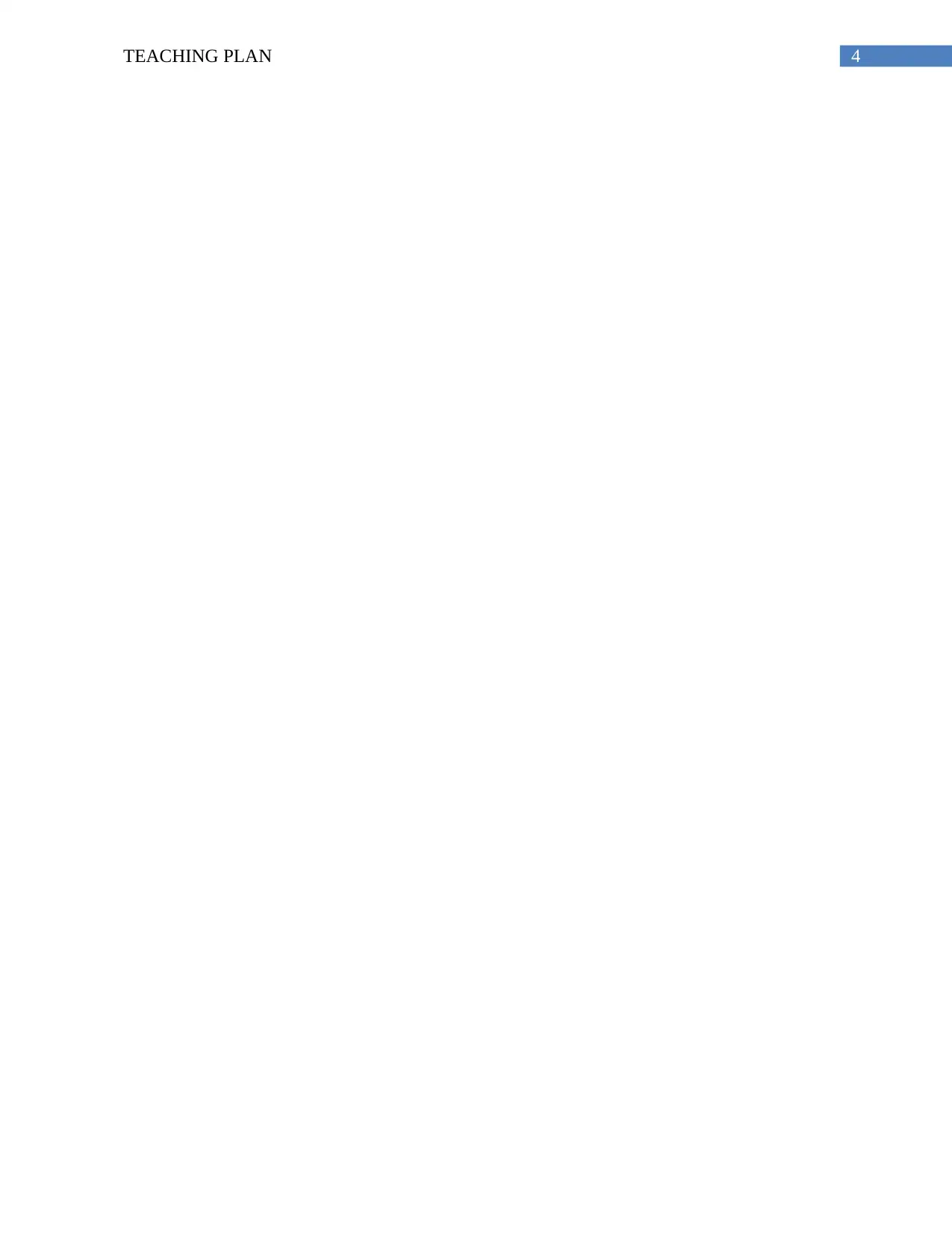
4TEACHING PLAN
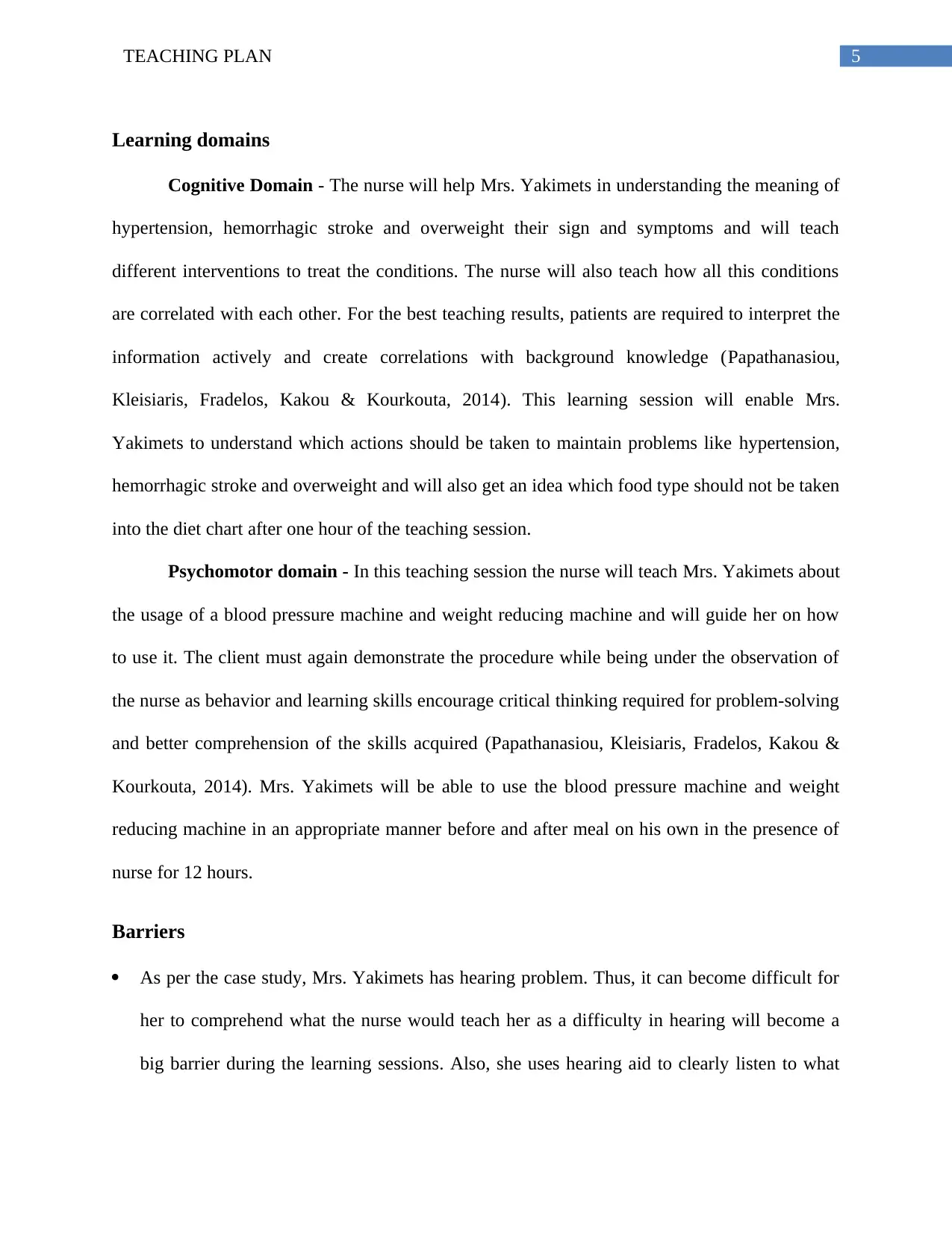
5TEACHING PLAN
Learning domains
Cognitive Domain - The nurse will help Mrs. Yakimets in understanding the meaning of
hypertension, hemorrhagic stroke and overweight their sign and symptoms and will teach
different interventions to treat the conditions. The nurse will also teach how all this conditions
are correlated with each other. For the best teaching results, patients are required to interpret the
information actively and create correlations with background knowledge (Papathanasiou,
Kleisiaris, Fradelos, Kakou & Kourkouta, 2014). This learning session will enable Mrs.
Yakimets to understand which actions should be taken to maintain problems like hypertension,
hemorrhagic stroke and overweight and will also get an idea which food type should not be taken
into the diet chart after one hour of the teaching session.
Psychomotor domain - In this teaching session the nurse will teach Mrs. Yakimets about
the usage of a blood pressure machine and weight reducing machine and will guide her on how
to use it. The client must again demonstrate the procedure while being under the observation of
the nurse as behavior and learning skills encourage critical thinking required for problem-solving
and better comprehension of the skills acquired (Papathanasiou, Kleisiaris, Fradelos, Kakou &
Kourkouta, 2014). Mrs. Yakimets will be able to use the blood pressure machine and weight
reducing machine in an appropriate manner before and after meal on his own in the presence of
nurse for 12 hours.
Barriers
As per the case study, Mrs. Yakimets has hearing problem. Thus, it can become difficult for
her to comprehend what the nurse would teach her as a difficulty in hearing will become a
big barrier during the learning sessions. Also, she uses hearing aid to clearly listen to what
Learning domains
Cognitive Domain - The nurse will help Mrs. Yakimets in understanding the meaning of
hypertension, hemorrhagic stroke and overweight their sign and symptoms and will teach
different interventions to treat the conditions. The nurse will also teach how all this conditions
are correlated with each other. For the best teaching results, patients are required to interpret the
information actively and create correlations with background knowledge (Papathanasiou,
Kleisiaris, Fradelos, Kakou & Kourkouta, 2014). This learning session will enable Mrs.
Yakimets to understand which actions should be taken to maintain problems like hypertension,
hemorrhagic stroke and overweight and will also get an idea which food type should not be taken
into the diet chart after one hour of the teaching session.
Psychomotor domain - In this teaching session the nurse will teach Mrs. Yakimets about
the usage of a blood pressure machine and weight reducing machine and will guide her on how
to use it. The client must again demonstrate the procedure while being under the observation of
the nurse as behavior and learning skills encourage critical thinking required for problem-solving
and better comprehension of the skills acquired (Papathanasiou, Kleisiaris, Fradelos, Kakou &
Kourkouta, 2014). Mrs. Yakimets will be able to use the blood pressure machine and weight
reducing machine in an appropriate manner before and after meal on his own in the presence of
nurse for 12 hours.
Barriers
As per the case study, Mrs. Yakimets has hearing problem. Thus, it can become difficult for
her to comprehend what the nurse would teach her as a difficulty in hearing will become a
big barrier during the learning sessions. Also, she uses hearing aid to clearly listen to what
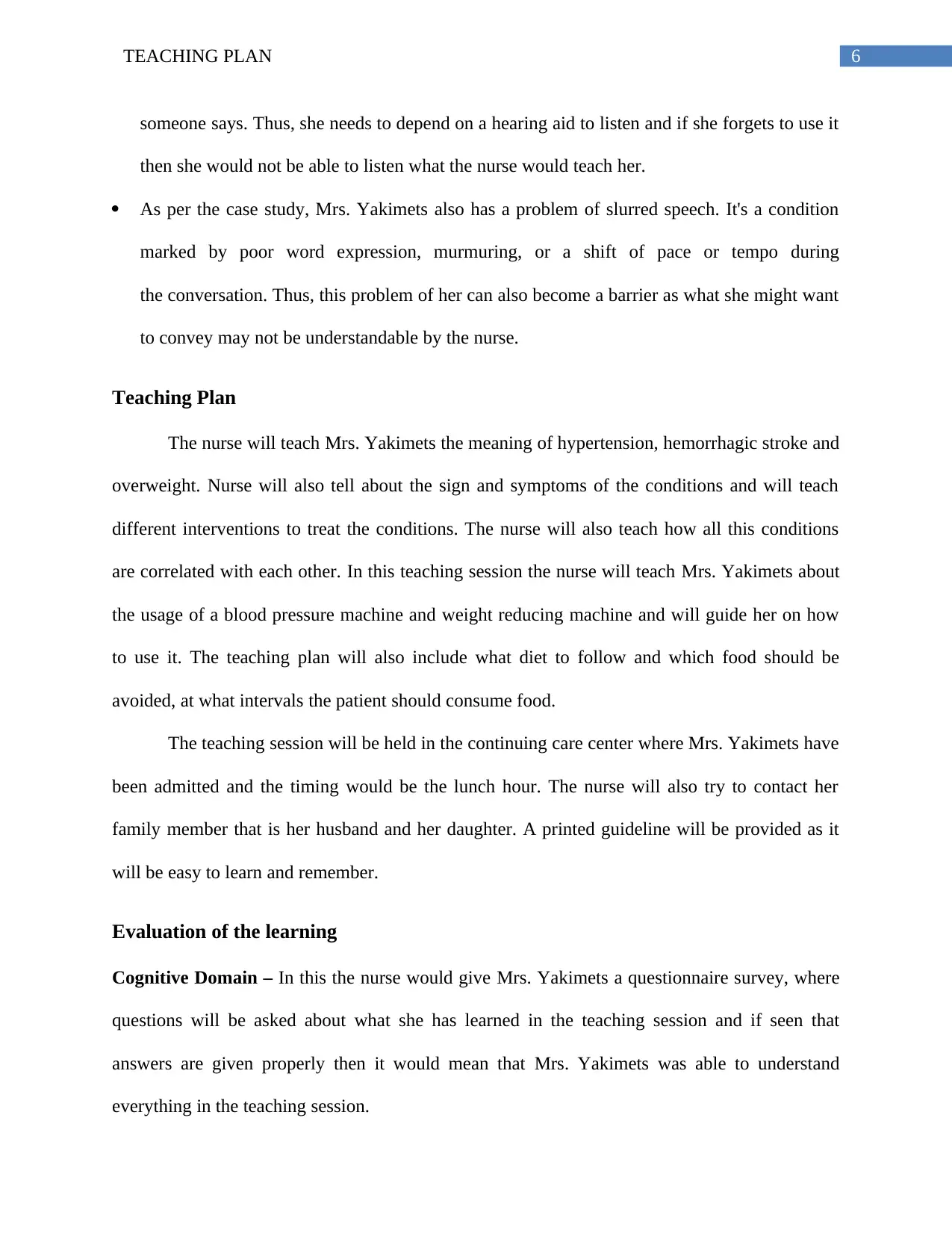
6TEACHING PLAN
someone says. Thus, she needs to depend on a hearing aid to listen and if she forgets to use it
then she would not be able to listen what the nurse would teach her.
As per the case study, Mrs. Yakimets also has a problem of slurred speech. It's a condition
marked by poor word expression, murmuring, or a shift of pace or tempo during
the conversation. Thus, this problem of her can also become a barrier as what she might want
to convey may not be understandable by the nurse.
Teaching Plan
The nurse will teach Mrs. Yakimets the meaning of hypertension, hemorrhagic stroke and
overweight. Nurse will also tell about the sign and symptoms of the conditions and will teach
different interventions to treat the conditions. The nurse will also teach how all this conditions
are correlated with each other. In this teaching session the nurse will teach Mrs. Yakimets about
the usage of a blood pressure machine and weight reducing machine and will guide her on how
to use it. The teaching plan will also include what diet to follow and which food should be
avoided, at what intervals the patient should consume food.
The teaching session will be held in the continuing care center where Mrs. Yakimets have
been admitted and the timing would be the lunch hour. The nurse will also try to contact her
family member that is her husband and her daughter. A printed guideline will be provided as it
will be easy to learn and remember.
Evaluation of the learning
Cognitive Domain – In this the nurse would give Mrs. Yakimets a questionnaire survey, where
questions will be asked about what she has learned in the teaching session and if seen that
answers are given properly then it would mean that Mrs. Yakimets was able to understand
everything in the teaching session.
someone says. Thus, she needs to depend on a hearing aid to listen and if she forgets to use it
then she would not be able to listen what the nurse would teach her.
As per the case study, Mrs. Yakimets also has a problem of slurred speech. It's a condition
marked by poor word expression, murmuring, or a shift of pace or tempo during
the conversation. Thus, this problem of her can also become a barrier as what she might want
to convey may not be understandable by the nurse.
Teaching Plan
The nurse will teach Mrs. Yakimets the meaning of hypertension, hemorrhagic stroke and
overweight. Nurse will also tell about the sign and symptoms of the conditions and will teach
different interventions to treat the conditions. The nurse will also teach how all this conditions
are correlated with each other. In this teaching session the nurse will teach Mrs. Yakimets about
the usage of a blood pressure machine and weight reducing machine and will guide her on how
to use it. The teaching plan will also include what diet to follow and which food should be
avoided, at what intervals the patient should consume food.
The teaching session will be held in the continuing care center where Mrs. Yakimets have
been admitted and the timing would be the lunch hour. The nurse will also try to contact her
family member that is her husband and her daughter. A printed guideline will be provided as it
will be easy to learn and remember.
Evaluation of the learning
Cognitive Domain – In this the nurse would give Mrs. Yakimets a questionnaire survey, where
questions will be asked about what she has learned in the teaching session and if seen that
answers are given properly then it would mean that Mrs. Yakimets was able to understand
everything in the teaching session.
Paraphrase This Document
Need a fresh take? Get an instant paraphrase of this document with our AI Paraphraser
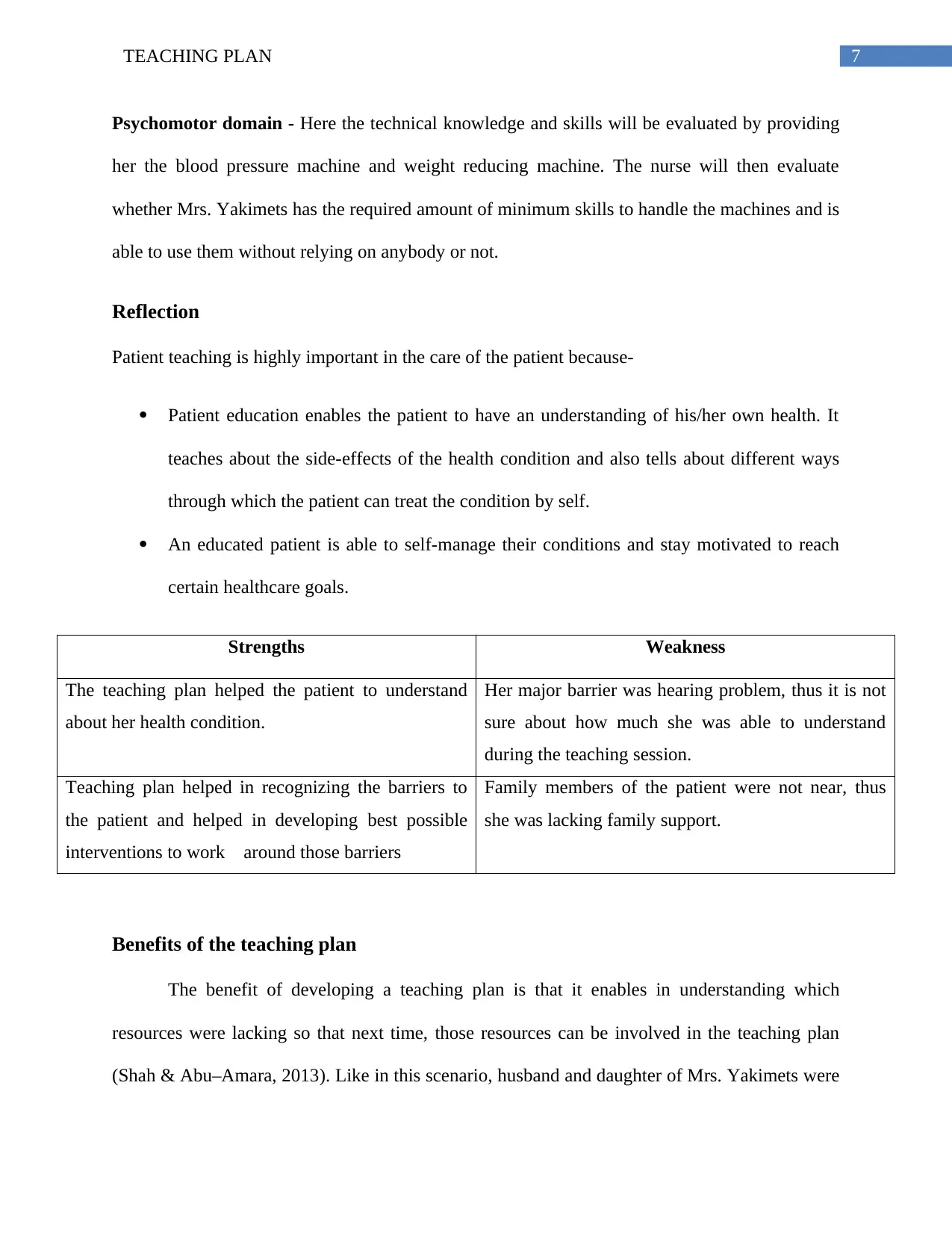
7TEACHING PLAN
Psychomotor domain - Here the technical knowledge and skills will be evaluated by providing
her the blood pressure machine and weight reducing machine. The nurse will then evaluate
whether Mrs. Yakimets has the required amount of minimum skills to handle the machines and is
able to use them without relying on anybody or not.
Reflection
Patient teaching is highly important in the care of the patient because-
Patient education enables the patient to have an understanding of his/her own health. It
teaches about the side-effects of the health condition and also tells about different ways
through which the patient can treat the condition by self.
An educated patient is able to self-manage their conditions and stay motivated to reach
certain healthcare goals.
Strengths Weakness
The teaching plan helped the patient to understand
about her health condition.
Her major barrier was hearing problem, thus it is not
sure about how much she was able to understand
during the teaching session.
Teaching plan helped in recognizing the barriers to
the patient and helped in developing best possible
interventions to work around those barriers
Family members of the patient were not near, thus
she was lacking family support.
Benefits of the teaching plan
The benefit of developing a teaching plan is that it enables in understanding which
resources were lacking so that next time, those resources can be involved in the teaching plan
(Shah & Abu–Amara, 2013). Like in this scenario, husband and daughter of Mrs. Yakimets were
Psychomotor domain - Here the technical knowledge and skills will be evaluated by providing
her the blood pressure machine and weight reducing machine. The nurse will then evaluate
whether Mrs. Yakimets has the required amount of minimum skills to handle the machines and is
able to use them without relying on anybody or not.
Reflection
Patient teaching is highly important in the care of the patient because-
Patient education enables the patient to have an understanding of his/her own health. It
teaches about the side-effects of the health condition and also tells about different ways
through which the patient can treat the condition by self.
An educated patient is able to self-manage their conditions and stay motivated to reach
certain healthcare goals.
Strengths Weakness
The teaching plan helped the patient to understand
about her health condition.
Her major barrier was hearing problem, thus it is not
sure about how much she was able to understand
during the teaching session.
Teaching plan helped in recognizing the barriers to
the patient and helped in developing best possible
interventions to work around those barriers
Family members of the patient were not near, thus
she was lacking family support.
Benefits of the teaching plan
The benefit of developing a teaching plan is that it enables in understanding which
resources were lacking so that next time, those resources can be involved in the teaching plan
(Shah & Abu–Amara, 2013). Like in this scenario, husband and daughter of Mrs. Yakimets were
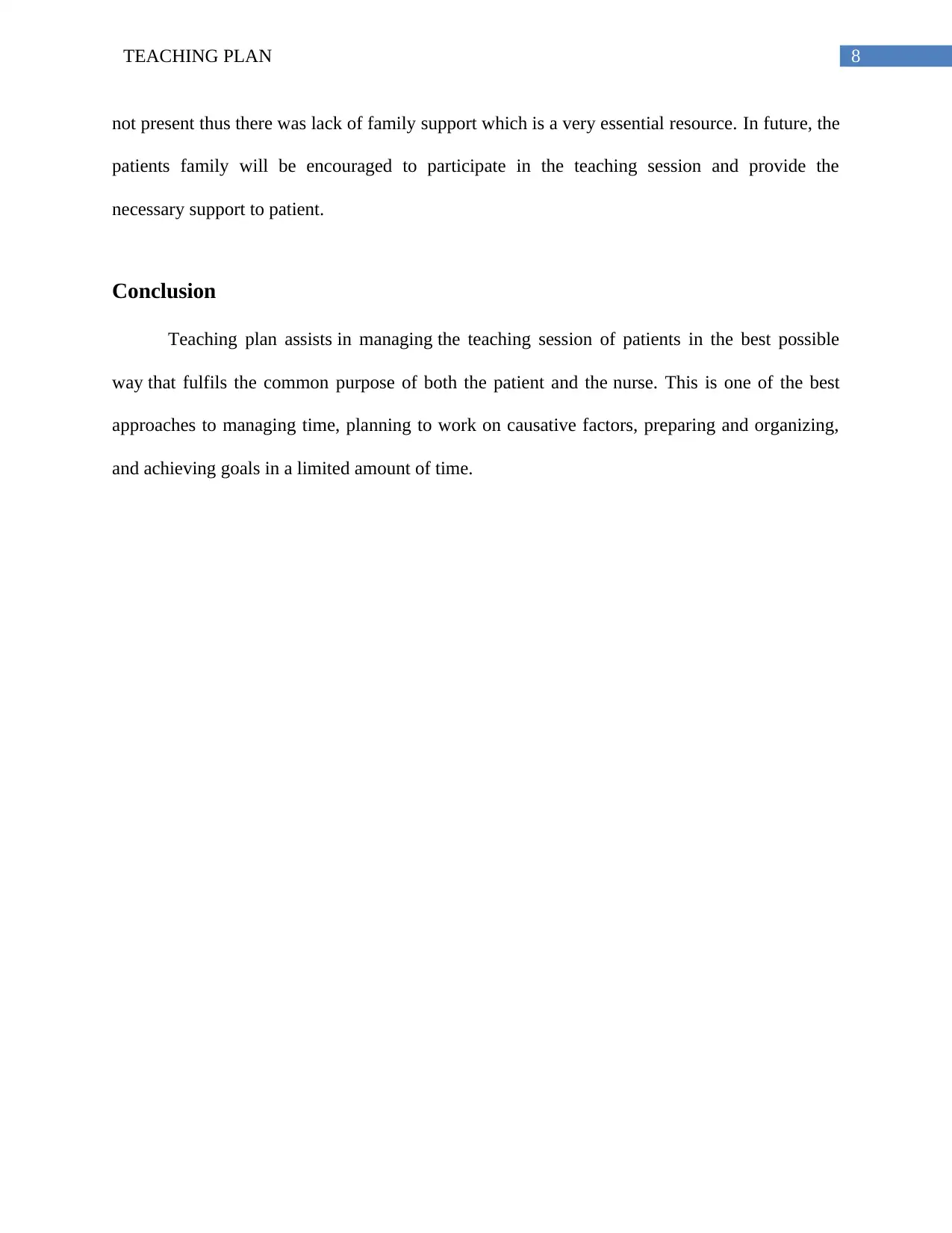
8TEACHING PLAN
not present thus there was lack of family support which is a very essential resource. In future, the
patients family will be encouraged to participate in the teaching session and provide the
necessary support to patient.
Conclusion
Teaching plan assists in managing the teaching session of patients in the best possible
way that fulfils the common purpose of both the patient and the nurse. This is one of the best
approaches to managing time, planning to work on causative factors, preparing and organizing,
and achieving goals in a limited amount of time.
not present thus there was lack of family support which is a very essential resource. In future, the
patients family will be encouraged to participate in the teaching session and provide the
necessary support to patient.
Conclusion
Teaching plan assists in managing the teaching session of patients in the best possible
way that fulfils the common purpose of both the patient and the nurse. This is one of the best
approaches to managing time, planning to work on causative factors, preparing and organizing,
and achieving goals in a limited amount of time.
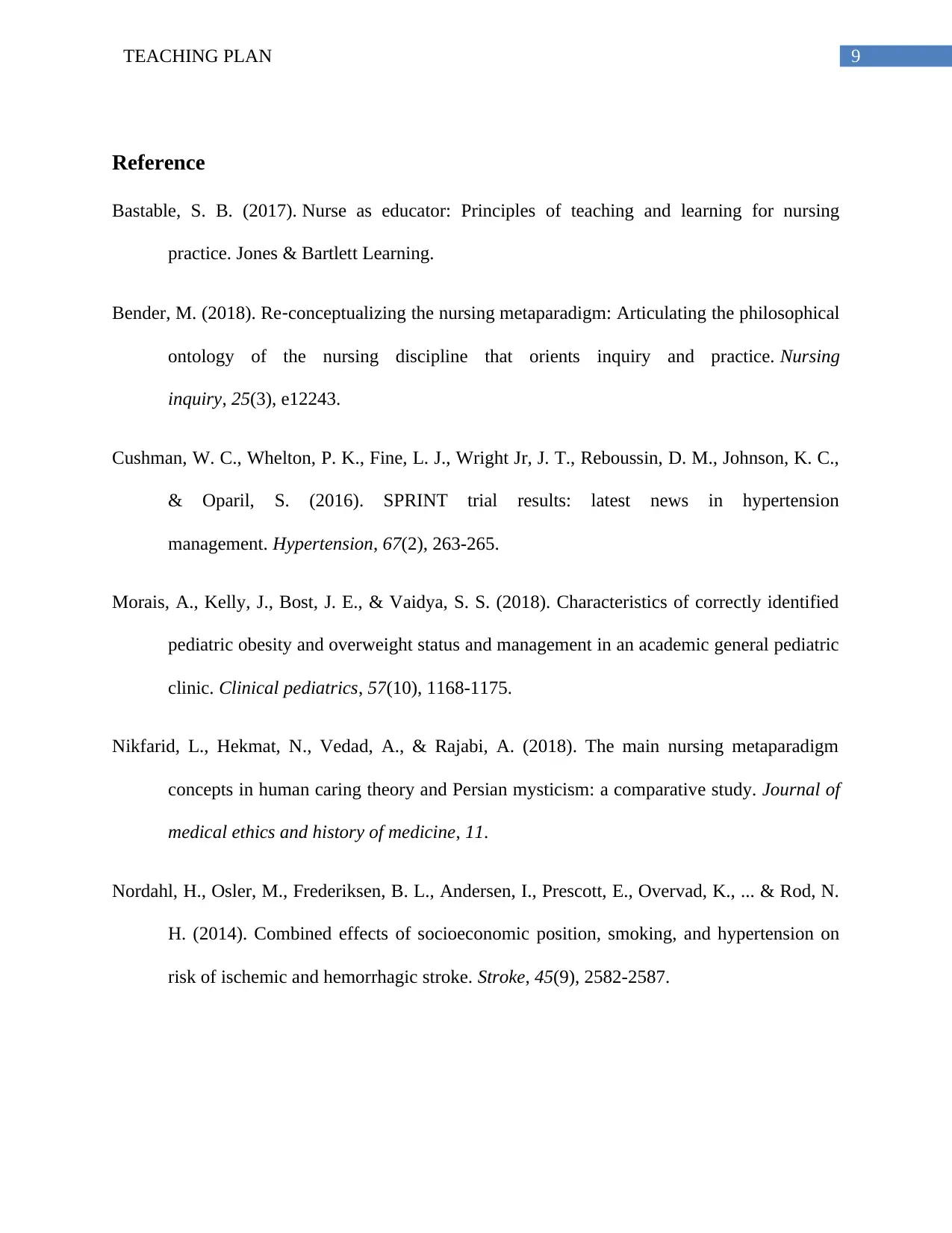
9TEACHING PLAN
Reference
Bastable, S. B. (2017). Nurse as educator: Principles of teaching and learning for nursing
practice. Jones & Bartlett Learning.
Bender, M. (2018). Re‐conceptualizing the nursing metaparadigm: Articulating the philosophical
ontology of the nursing discipline that orients inquiry and practice. Nursing
inquiry, 25(3), e12243.
Cushman, W. C., Whelton, P. K., Fine, L. J., Wright Jr, J. T., Reboussin, D. M., Johnson, K. C.,
& Oparil, S. (2016). SPRINT trial results: latest news in hypertension
management. Hypertension, 67(2), 263-265.
Morais, A., Kelly, J., Bost, J. E., & Vaidya, S. S. (2018). Characteristics of correctly identified
pediatric obesity and overweight status and management in an academic general pediatric
clinic. Clinical pediatrics, 57(10), 1168-1175.
Nikfarid, L., Hekmat, N., Vedad, A., & Rajabi, A. (2018). The main nursing metaparadigm
concepts in human caring theory and Persian mysticism: a comparative study. Journal of
medical ethics and history of medicine, 11.
Nordahl, H., Osler, M., Frederiksen, B. L., Andersen, I., Prescott, E., Overvad, K., ... & Rod, N.
H. (2014). Combined effects of socioeconomic position, smoking, and hypertension on
risk of ischemic and hemorrhagic stroke. Stroke, 45(9), 2582-2587.
Reference
Bastable, S. B. (2017). Nurse as educator: Principles of teaching and learning for nursing
practice. Jones & Bartlett Learning.
Bender, M. (2018). Re‐conceptualizing the nursing metaparadigm: Articulating the philosophical
ontology of the nursing discipline that orients inquiry and practice. Nursing
inquiry, 25(3), e12243.
Cushman, W. C., Whelton, P. K., Fine, L. J., Wright Jr, J. T., Reboussin, D. M., Johnson, K. C.,
& Oparil, S. (2016). SPRINT trial results: latest news in hypertension
management. Hypertension, 67(2), 263-265.
Morais, A., Kelly, J., Bost, J. E., & Vaidya, S. S. (2018). Characteristics of correctly identified
pediatric obesity and overweight status and management in an academic general pediatric
clinic. Clinical pediatrics, 57(10), 1168-1175.
Nikfarid, L., Hekmat, N., Vedad, A., & Rajabi, A. (2018). The main nursing metaparadigm
concepts in human caring theory and Persian mysticism: a comparative study. Journal of
medical ethics and history of medicine, 11.
Nordahl, H., Osler, M., Frederiksen, B. L., Andersen, I., Prescott, E., Overvad, K., ... & Rod, N.
H. (2014). Combined effects of socioeconomic position, smoking, and hypertension on
risk of ischemic and hemorrhagic stroke. Stroke, 45(9), 2582-2587.
Secure Best Marks with AI Grader
Need help grading? Try our AI Grader for instant feedback on your assignments.
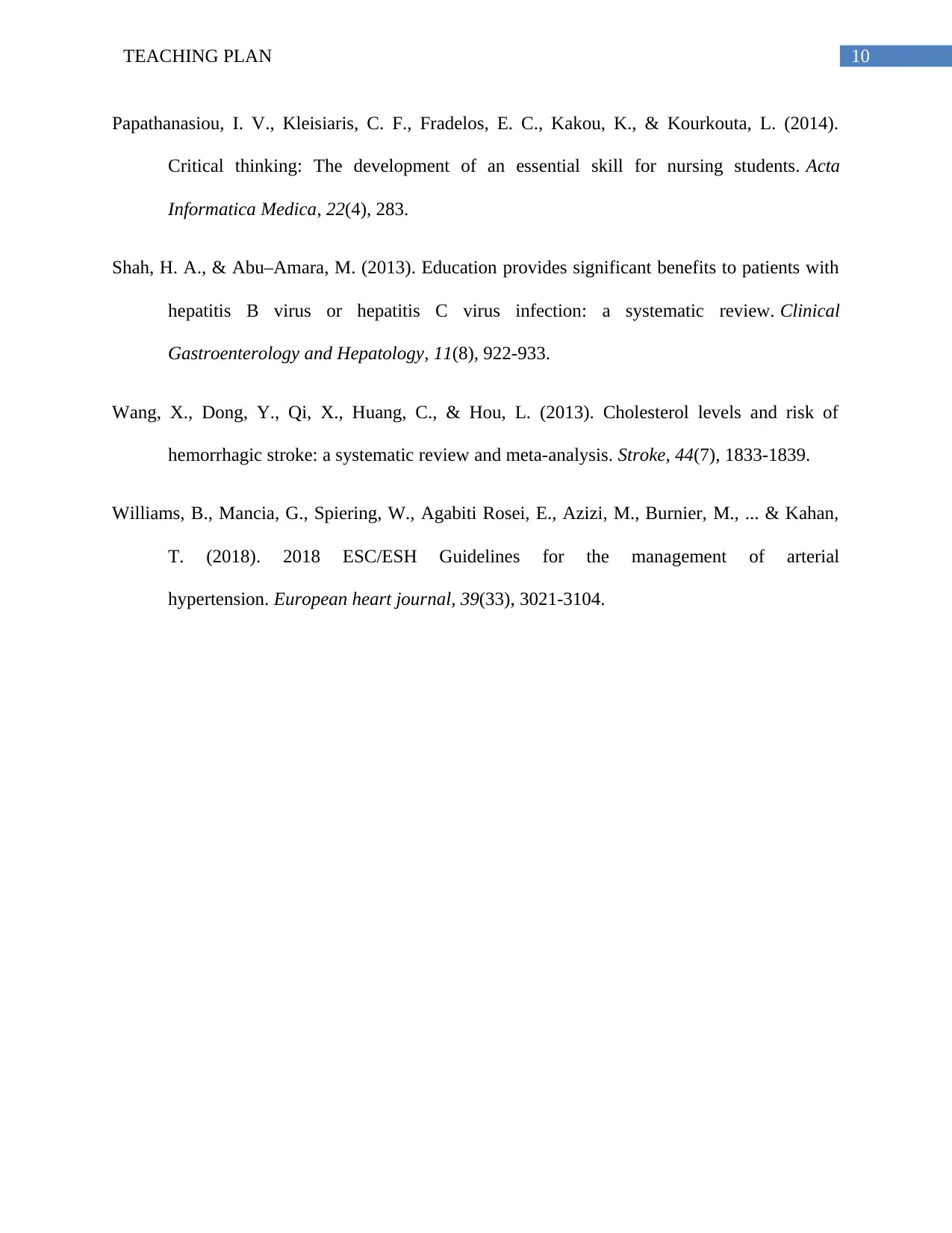
10TEACHING PLAN
Papathanasiou, I. V., Kleisiaris, C. F., Fradelos, E. C., Kakou, K., & Kourkouta, L. (2014).
Critical thinking: The development of an essential skill for nursing students. Acta
Informatica Medica, 22(4), 283.
Shah, H. A., & Abu–Amara, M. (2013). Education provides significant benefits to patients with
hepatitis B virus or hepatitis C virus infection: a systematic review. Clinical
Gastroenterology and Hepatology, 11(8), 922-933.
Wang, X., Dong, Y., Qi, X., Huang, C., & Hou, L. (2013). Cholesterol levels and risk of
hemorrhagic stroke: a systematic review and meta-analysis. Stroke, 44(7), 1833-1839.
Williams, B., Mancia, G., Spiering, W., Agabiti Rosei, E., Azizi, M., Burnier, M., ... & Kahan,
T. (2018). 2018 ESC/ESH Guidelines for the management of arterial
hypertension. European heart journal, 39(33), 3021-3104.
Papathanasiou, I. V., Kleisiaris, C. F., Fradelos, E. C., Kakou, K., & Kourkouta, L. (2014).
Critical thinking: The development of an essential skill for nursing students. Acta
Informatica Medica, 22(4), 283.
Shah, H. A., & Abu–Amara, M. (2013). Education provides significant benefits to patients with
hepatitis B virus or hepatitis C virus infection: a systematic review. Clinical
Gastroenterology and Hepatology, 11(8), 922-933.
Wang, X., Dong, Y., Qi, X., Huang, C., & Hou, L. (2013). Cholesterol levels and risk of
hemorrhagic stroke: a systematic review and meta-analysis. Stroke, 44(7), 1833-1839.
Williams, B., Mancia, G., Spiering, W., Agabiti Rosei, E., Azizi, M., Burnier, M., ... & Kahan,
T. (2018). 2018 ESC/ESH Guidelines for the management of arterial
hypertension. European heart journal, 39(33), 3021-3104.
1 out of 11
Related Documents
Your All-in-One AI-Powered Toolkit for Academic Success.
+13062052269
info@desklib.com
Available 24*7 on WhatsApp / Email
![[object Object]](/_next/static/media/star-bottom.7253800d.svg)
Unlock your academic potential
© 2024 | Zucol Services PVT LTD | All rights reserved.





